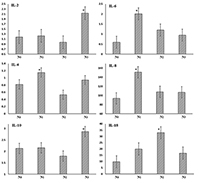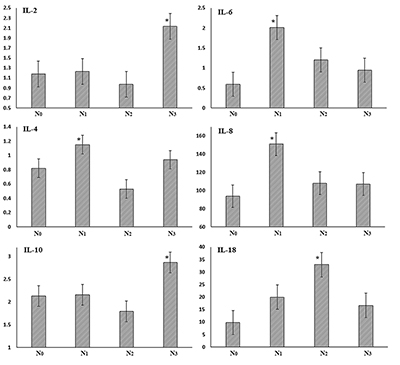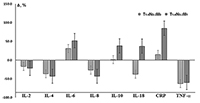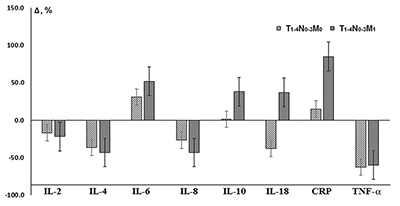Уровень цитокинов слюны при раке легкого на фоне отдаленного и регионарного метастазирования
1ООО «ХимСервис», 143026, Москва, Территория инновационного центра Сколково, ул. Луговая, 4/2,
*e-mail: ludab2005@mail.ru
2Омский государственный медицинский университет, 644099, Омск, ул. Ленина, 12
3Strasbourg University Hospital, 67091 Strasbourg, France
4Клинический онкологический диспансер, 644013, Омск, ул. Завертяева, 9/1
Ключевые слова: цитокины; С-реактивный белок; слюна; рак легкого
DOI: 10.18097/BMCRM00012
До настоящего времени остаются актуальными проблемы оптимизации методов диагностики и прогнозирования течения рака легкого, занимающего лидирующие позиции в структуре онкологических заболеваний. Цель исследования: изучение уровня цитокинов и острофазовых белков в слюне пациентов с раком легкого в зависимости от размера опухоли, а также на фоне отдаленного и регионарного метастазирования. В исследовании случай – контроль приняли участие 121 человек, которые были разделены на 3 группы: основную (с диагнозом рак легкого, n=70), группу сравнения (с незлокачественными патологиями легких, n=12) и контрольную группу (условно здоровые, n=39). Всем участникам было проведено анкетирование, биохимическое исследование слюны, гистологическая верификация диагноза. Межгрупповые различия оценены непараметрическим критерием. Показано, что уровни цитокинов в слюне больных раком легкого и здоровых людей статистически достоверно не отличаются. Содержание ИЛ-2 и ИЛ-4 в слюне уменьшается как в случае рака легкого, так и при воспалительных заболеваниях легких, тогда как уровни ИЛ-8, ИЛ-18 и ФНО-α при раке легкого снижаются, а на фоне неопухолевых патологий растут. При прогрессировании опухоли уровень провоспалительных цитокинов (ИЛ-6, ИЛ-8, ИЛ-18, ФНО-α) растет, тогда как ИЛ-2, ИЛ-4 и ИЛ-10 уменьшается. Отмечено увеличение уровня С-реактивного белка и опухолевых маркеров в динамике рака легкого, однако достоверных отличий от воспалительных заболеваний легких не выявлено.


|
Рисунок 2.
Динамика уровня цитокинов (пг/мл) в зависимости от степени распространенности регионарного метастазирования (* - изменение концентрации статистически достоверно, р˂0.05)
|
|
ЗАКРЫТЬ ОКНО

|
Таблица 1.
Уровень цитокинов в слюне пациентов исследуемых групп
|
|
ЗАКРЫТЬ ОКНО

|
Таблица 2.
Уровень цитокинов и опухолевых маркеров в слюне в зависимости от гистологического типа рака легкого
|
|
ЗАКРЫТЬ ОКНО

|
Таблица 3.
Динамика уровня цитокинов в слюне в зависимости от размера опухоли
|
|
ЗАКРЫТЬ ОКНО

|
Таблица 4.
Динамика уровня цитокинов в слюне в зависимости от наличия/отсутствия регионарного и отдаленного метастазирования
|
REFERENCES
- Brailo, V., Vucicevic-Boras, V., Lukac, J., Biocina-Lukenda, D., Zilic-Alajbeg, I., Milenovic, A. & Balija, M. (2012). Salivary and serum interleukin 1 beta, interleukin 6 and tumor necrosis factor alpha in patients with leukoplakia and oral cancer. Med Oral Patol Oral Cir Bucal, 17, e10-e15. DOI
- Byrne, M.L., O’Brien-Simpson, N.M., Reynolds, E.C., Walsh, K.A., Laughton, K., Waloszek, J.M., Woods, M.J., Trinder, J. & Allen, N.B. (2013). Acute phase protein and cytokine levels in serum and saliva: A comparison of detectable levels and correlations in a depressed and healthy adolescent sample. Brain Behav Immun, 34, 164-75. DOI
- Gilbertson-White, S., Aouizerat, B.E. & Miaskowski, C. (2011). Methodologic issues in the measurement of cytokines to elucidate the biological basis for cancer symptoms. Biol Res Nurs, 13, 15-24. DOI
- Khan, A. (2012). Detection and quantitation of forty-eight cytokines, chemokines, growth factors and nine acute phase proteins in healthy human plasma, saliva and urine. J Proteom, 75, 4802-4819. DOI
- Fernandez-Botran, R., Miller, J.J., Burns, V.E. & Newton, T.L. (2011). Correlations among inflammatory markers in plasma, saliva and oral mucosal transudate in postmenopausal women with past intimate partner violence. Brain Behav Immun, 25, 314-321. DOI
- Williamson, S., Munro, C., Pickler, R., Grap, M.J. & Elswick, R.K. (2012). Comparison of biomarkers in blood and saliva in healthy adults. Nurs Res Pract, Article ID 246178. DOI
- Cullen, T., Thomas, A.W., Webb, R. & Hughes, M.G. (2015). The relationship between interleukin-6 in saliva, venous and capillary plasma, at rest and in response to exercise. Cytokine, 71(2), 397-400. DOI
- Ouellet-Morin, I., Danese, A., Williams, B. & Arseneault, L. (2011). Validation of a high-sensitivity assay for C-reactive protein in human saliva. Brain Behav Immun, 25, 640-646. DOI
- Mirzaii-Dizgah, I., Riahi, E. & Miri, R. (2012). Serum and saliva levels of high-sensitivity C-reactive protein in acute myocardial infarction. J Mol Biomark Diagn, 3(4). DOI
- Pfaffe, T., Cooper-White, J., Beyerlein, P., Kostner, K. & Punyadeera, C. (2011). Diagnostic potential of saliva. Current state and future applications. Clin Chem, 57, 675-687. DOI
- Javaid, M.A., Ahmed, A.S., Durand, R. & Tran, S.D. (2016). Saliva as a diagnostic tool for oral and systemic diseases. J Oral Biol Craniofac Res, 6(1), 67-76. DOI
- Suzuki, T., Omata, K., Satoh, T., Miyasaka, T., Arai, C., Maeda, M., Matsuno, T. & Miyamura, T. (2005). Quantitative detection of hepatitis C virus (HCV) RNA in saliva and gingival crevicular fluid of HCV-infected patients. J Clin Microbiol, 43, 4413-4417. DOI
- Shipper, R.G., Silletti, E. & Vingerhoeds, M.H. (2007). Saliva as research material: Biochemical, physicochemical and practical aspects. Arch Oral Biol, 52, 1114-1135. DOI
- Papacosta, E. & Nassis, G.P. (2011). Saliva as a tool for monitoring steroid, peptide and immune markers in sport and exercise science. J Sci Med Sport, 14, 424-234. DOI
- Granger, D.A., Kivlighan, K.T., Fortunato, C., Harmon, A.G., Hibel, L.C., Schwartz, E.B. & Whembolua, G-L. (2007). Integration of salivary biomarkers into developmental and behaviorally-oriented research: problems and solutions for collecting specimens. Physiol Behav, 92, 583-590. DOI
- Isaza-Guzmán, D.M., Cardona-Vélez, N., Gaviria-Correa, D.E., Martínez-Pabón, M.C., Castano-Granada, M.C. & Tabón-Arroyave, S.I. (2015). Association study between salivary levels of interferon (IFN)-gamma, interleukin (IL)-17, IL-21, and IL-22 with chronic periodontitis. Arch Oral Biol, 60, 91-99. DOI
- Dafar, A., Rico, P., Işik, A., Jontell, M. & Cevik-Aras, H. (2014). Quantitative detection of epidermal growth factor and interleukin-8 in whole saliva of healthy individuals. J Immunol Methods, 408: 46-51. DOI
- Aleynikov, A.S., Gayduk, I.V., Panin, A.M., Babkina, I.V. & Kushlinsky, N.E. (2014). Proinflammatory cytokines in saliva of patients with chronic sialodochitis. TSU Bulletin, 19(6), 1909-1914.
- Rhodus, N.L., Ho, V., Miller, C.S., Myers, S. & Ondrey, F. (2005). NF-kB dependent cytokine levels in saliva of patients with oral preneoplastics lesions and oral squamous cell carcinoma. Cancer Detect Prev, 29, 42-45. DOI
- Schapher, M., Wendler, O. & Gröschl, M. (2011). Salivary cytokines in cell proliferation and cancer. Clin Chim Acta, 412, 1740-1748. DOI
- Russo, N., Bellile, E., Murdoch-Kinch, C.A., Liu, M., Eisbruch, A., Wolf, G.T. & D’Silva, N.J. (2016). Cytokines in saliva increase in head and neck cancer patients after treatment. Oral Surg Oral Med Oral Pathol Oral Radiol, 122(4): 483-490. DOI
- Osman, T.A., Costea, D.E. & Johannessen, A.C. (2012). The use of salivary cytokines as a screening tool for oral squamous cell carcinoma: A review of the literature. J Oral Maxillofac Pathol, 16(2), 256-261. DOI
- Jacobs, R., Tshehla, E., Malherbe, S., Kriel, M., Loxton, A.G., Stanley, K., van der Spuy, G., Walzl, G. & Chegou, N.N. (2016). Host biomarkers detected in saliva show promise as markers for the diagnosis of pulmonary tuberculosis disease and monitoring of the response to tuberculosis treatment. Cytokine, 81, 50-56. DOI
- Yano, T., Yoshino, L., Yokoyama, H., Fukuyama, Y., Takai, E., Asoh, H. & Ichinose, Y. (1996). The clinical significance of serum soluble interleukin-2 receptors in lung cancer. Lung Cancer, 15, 79-84. DOI
- Chi ,X. & Tai, H-H. (2010). Interleukin-4 up-regulates 15-hydroxyprostaglandin dehydrogenase (15-PGDH) in human lung cancer cells. Exp Cell Res, 316, 2251-2259. DOI
- Ryan, B.M., Pine, S.R., Chaturvedi, A.K., Caporaso, N. & Harris, C.C. (2014). A combined prognostic serum interleukin-8 and interleukin-6 classifier for stage 1 lung cancer in the prostate, Lung, colorectal, and ovarian cancer screening trial. J Thorac Oncol, 9(10), 1494-1503. DOI
- Luppi, F., Longo, A.M., de Boer, W.I., Rabe, K.F. & Hiemstra P.S. (2007). Interleukin-8 stimulates cell proliferation in non-small cell lung cancer through epidermal growth factor receptor transactivation. Lung Cancer, 56, 25-33. DOI
- Rovina, N., Hillas, G., Dima, E., Vlastos, F., Loukides, S., Veldekis, D., Rousso, C., Alhanatis, M. & Bakakos, P. (2011). VEGF and IL-18 in induced sputum of lung cancer patients. Cytokine, 54, 277-281. DOI
- O’Dowd, C., McRae, L.A., McMillan, D.C., Kirk, A. & Milroy, R. (2010). Elevated preoperative C-reactive protein predicts poor cancer specific survival in patients undergoing resection for non-small cell lung cancer. J Thorac Oncol, 5(7), 988-992. DOI
- Hoseok, I. & Cho, J-Y. (2015). Lung cancer biomarkers. Adv Clin Chem, 72, 107-170. DOI
- Shcheglova, M.Yu. (2005). System of cytokines in health and respiratory disease. Bulletin of Physiology and Respiration Pathology, 21, 93-97.
- Akdis, M., Aab, A., Altunbulakli, C., Azkur, K., Costa, R.A. & Crameri, R. (2016). Interleukins (from IL-1 to IL-38), interferons, transforming growth factor b, and TNF-a: Receptors, functions, and roles in diseases. J Allergy Clin Immunol, 138(4), 984-1010. DOI
- Nelms, K., Keegan, A.D., Zamorano, J., Ryan, J.J. & Paul, W.E. (1999). The IL-4 receptor: signaling mechanisms and biologic functions. Annu Rev Immunol, 17, 701-738. DOI
- Ho, L-J., Luo, S-F. & Lai, J-H. (2015). Biological effects of interleukin-6: Clinical applications in autoimmune diseases and cancers. Biochem Pharmacol, 97(1), 16-26. DOI
- Seike, M., Yanaihara, N. & Bowman, E.D. (2007). Use of a cytokine gene expression signature in lung adenocarcinoma and the surrounding tissue as a prognostic classifie. J Natl Cancer Inst, 99, 1257-1269. DOI
- Yatsunami, J., Tsuruta, N., Ogata, K., Wakamatsu, K., Takayama, K., Kawasaki, M., Nakanishi, Y., Hara, N. & Hayashi, S. (1997). Interleukin-8 participates in angiogenesis in non-small cell, but not small cell carcinoma of the lung. Cancer Lett, 120, 101-108. DOI
- Pine, S.R., Mechanic, L.E. & Enewold, L. (2011). Increased levels of circulating interleukin 6, interleukin 8, C-reactive protein, and risk of lung cancer. J Natl Cancer Inst, 103, 1112‑1122. DOI
- Crohns, M., Saarelainen, S., Laine, S., Poussa, T., Alho, H. & Kellokumpu-Lehtinen, P. (2010). Cytokines in bronchoalveolar lavage fluid and serum of lung cancer patients during radiotherapy — Association of interleukin-8 and VEGF with survival. Cytokine, 50, 30-36. DOI
- Erzutova, M.V., Uspenskaya, I.D., Majanskaya, I.V., Korkotashvili, L.V. & Potekhin, P.P. (2011). Significance of proinflammatory cytokines in a mouth cavity secret in patients with celiac disease. Medical Almanac, 6(19), 179-182.
- Black, S., Kushner, I. & Samols, D. (2004). C-reactive protein. J Biol Chem, 279(47), 48487-48490. DOI
- Chaturvedi, A.K., Caporaso, N.E. & Katki, H.A. (2010). C-reactive protein and risk of lung cancer. J Clin Oncol, 28, 2719-2726. DOI
- Wu, Y., Potempa, L.A., El Kebir, D. & Filep, J.G. (2015). C-reactive protein and inflammation: conformational changes affect function. Biol Chem, 396(11), 1181-1197. DOI
- Pastorino, U., Morelli, D., Leuzzi, G., Gisabella, M., Suatoni, P., Taverna, F., Bertocchi, E., Boeri, M., Sozzi, G., Cantarutti, A. & Corrao, G. (2017). Baseline and postoperative C-reactive protein levels predict mortality in operable lung cancer. Eur J Cancer, 79, 90-97. DOI
- Jin, Y., Sun, Y., Shi, X., Zhao, J., Shi, L. & Yu, X. (2014). Prognostic value of circulating C-reactive protein levels in patients with non-small cell lung cancer: a systematic review with meta-analysis. J Cancer Res Ther, 10, 160-166. DOI
- Saeed, A.I., Qeadan, F., Sood, A., VanderJagt, D.J., Mishra, S.I., Hill, D.A., Peikert, T. & Sopori, M.L. (2017). A novel cytokine profile associated with cancer metastasis to mediastinal and hilar lymph nodes identified using fine needle aspiration biopsy – A pilot study. Cytokine, 89, 98-104. DOI
- Perlikos, F., Harrington, K.J. & Syrigos, K.N. (2013). Key molecular mechanisms in lung cancer invasion and metastasis: A comprehensive review. Crit Rev Oncol./Hematol, 87, 1-11. DOI

